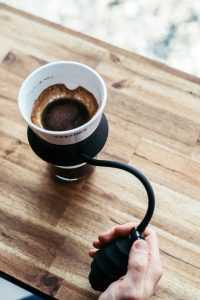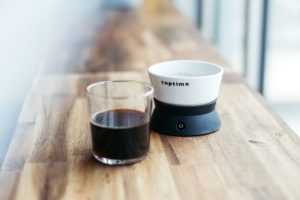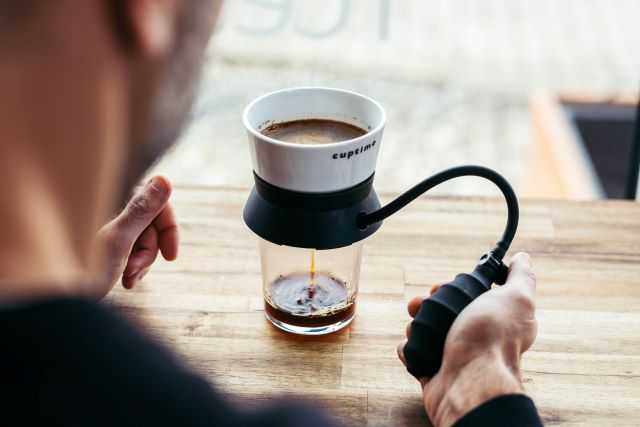MILAN – The world of coffee is constantly moving and evolving through innovations that are expressed in the equipment at the service of baristas and coffeelovers. In the search for the perfect extraction tool, engineers and designers put their expertise and creativity at the service of the industry. Among these inventors, always guided by a passion for quality drinks, is the mechanical engineer from Austria, Wolfgang Muckenhuber, creator of the manual vacuum coffee brewer cuptimo.
That’s how he introduced himself to our readers, to better understand his path into the specialties: “During University I started working for a friend who opened up a coffee roastery (www.suchan.coffee) – this was my first contact with specialty coffee. Later, I moved to Germany where I met my wife.
She is from Brazil and has coffee growers and roasters in her family. Then two other Friends of mine opened up a roastery in Germany (www.roestkaffee.de). So I experienced the whole coffee supply chain first hand and it fascinated me. All the resources, amount of work and dedication put into specialty coffee is amazing. But my wife and I where not happy with the options to brew this great product.”
That’s the reasons behind cuptimo: it can be applied to filter coffee, especially light roasts, cold brew, turkish coffee or any other suspension and, additionally to soft pads (e.g. Senseo – Format).
Basically we’re looking at a small but substantial change for this type of extraction, a more than valid alternative in terms of both the final result in the cup and the choice of shapes and materials. To better understand its essence and how it works, we spoke directly with its inventor.
Cuptimo: its soul and components
First, let us start by exploring its components and technical features to better understand how cuptimo works.
Brewing vessel: The porcelain-brewing vessel allows easy filling with coffee grounds and water due to its conical format. The shape facilitates manual agitation as well as cleaning, either by hand or in the dishwasher. The vessel is custom hand made by a family owned company in Bavaria/Germany and guarantees timelessness, food safety and pure taste.
Collar: it is made of solid, food safe silicone in accordance to FDA and EU standards. It holds the brewing vessel on the cup providing an airtight seal between both components. An air duct is integrated into the collar where the manual pump can be connected. The collar is also dishwasher safe.
Manual Pump: it is used to evacuate the volume beneath the brewer, pulling the water through the coffee bed. Before taking cuptimo off the cup, the negative pressure has to be released. This can be done by pressing the button on the pump.
Filter paper: to be able to guarantee the necessary quality and taste, solely companies that manufacture in compliance to German quality and food safety standards have been considered. Several filters have been tested and the filter papers chosen for cuptimo stood out by its taste characteristics. cuptimo`s filter paper is manufactured in Switzerland, using Alp spring water in a non-circulatory process, which avoids negative taste effects on the coffee.
But how does cuptimo work?
First, a filter paper disk is placed in the brewing vessel and rinsed with some water so that it adheres to the bottom. The cuptimo brewer is placed on top of a cup or a carafe with a level top lid. This is necessary to enable the negative pressure to be build up for accelerated extraction. cuptimo is a full immersion brewer.
All the brewing water can get in contact with the coffee at the same time. To improve even extraction, the slurry can be agitated with various methods through the top opening of the brewing vessel. cuptimo allows to use finer grind sizes than other filter brewing methods, ranging from 2 to 20+ clicks on the Comandante Grinder.
To start the vacuum extraction, the hose of the manual pump is connected to the collar and the user starts pumping. By doing so, the volume beneath the brewer is evacuated. The resulting negative pressure pulls the brewing water through the coffee bed. Once all the coffee is in the cup, the vacuum can be released by pushing the button on the manual pump for taking off the brewer.
Wolfgang, how and when have you decided to create cuptimo?
“Not happy with the available brewing options, I started to research and read every scientific paper on coffee brewing I could find. I understood that in theory full immersion brewing in combination with vacuum extraction should deliver the coffee I desire. In fact, the coffee syphon, known for decades, does exactly that. Downside of the syphon is that it not only consists of several parts, but is also not very easy to operate neither to clean. Besides, it brews with boiling hot water, which is not always what you want with specialty
coffee. So for five years I have been working on this topic and about three years ago I identified the principle on which cuptimo was developed on.”
Could you explain how the cuptimo full immersion brewing in combination with zero-bypass vacuum extraction can maximize the result in the cup?

“Full immersion means that all coffee gets in contact with all of the brewing water at the same moment, allowing the extraction process to start uniformly. As opposed to a pour over brewer, where fresh brewing water is poured over the coffee grounds in intervals.
Using cuptimo, the desired time of extraction is controlled by the user, after which all the water is pulled through the disc shaped coffee bed by negative pressure. This means that all the water has to pass through the coffee uniformly, leaving a coffee bed that has a constant height. In conical shaped drip brewers the water can take different paths or even bypass outside of the filter into the cup.
The application of the vacuum (technically correct term is negative pressure) enhances and accelerates the extraction process, minimizes the occurrence of channeling (local over extraction), and results in unique flavor profile of vacuum extraction: sweet, balanced taste with reduced bitterness.
Additionally, the cuptimo brewing method offers the possibility to brew with very fine grounded coffee, reducing the size variation of the coffee particles, and further facilitating an even extraction. All this factors in combination deliver extraction results (e.g. Total Dissolved Solids 1,8% at 1/17 brew ratio; Extraction Yield 28%) that haven’t been seen with other brewing methods. But in the end, what really matters is the taste of course.”
The manual pump is something that makes the barista seem more like a doctor: why is it important in the cuptimo system?

“With the manual pump the negative pressure is created, accelerating and enhancing the extraction. By using a manual pump you can freely decide how long the coffee should stay immersed and how fast it should be extracted.”
Let’s talk about the porcelain-brewing vessel: why did you choose this material – instead of plastic for example that is more common – and why did you give it that specific shape?
“For me, understanding the specialty coffee supply chain and the amount of work that is invested, this effort has to be appreciated by selecting only the best materials. In laboratories, experiments are done in glass or porcelain containers as these are inert materials, which means they do not interfere with the material being analyzed.
The first time this really came to my attention, was when I had coffee from a “Karlsbader Kanne”, a brewer made solely from porcelain, even the filter. The taste of that coffee was different. It tasted so pure. I wanted that also for my brewer. And why shouldn’t specialty coffee be prepared and served from glass or porcelain when this is normal for other food and beverage specialties like a nice steak or a good wine?

The features of modern plastic material are of course appealing. They are cheap in mass production, nearly unbreakable and have excellent thermal properties. But I believe that for specialty coffee a material like porcelain is the right choice. The shape of the brewing vessel is the result of an optimization process in combination with ergonomic considerations. Finding the optimum diameter of the vessel base was a long trial process with many prototypes that were tested against each other. The conical shape facilitates handling and cleaning.”
What is the feedback from the community?
“The first impression by many is that cuptimo is a freaky device because of the pump. But after trying it users tend to find cuptimo easy to operate and are surprised by the flavor profile of the resulting cup. Another factor that is quite surprising for the users is that cuptimo is so flexible: They can experiment with a wide variety of grind sizes and prepare cold brew very fast. cuptimo can also be used to brew coffee soft pads – if necessary.”
What’s cuptimo’s main target? The baristas in coffee shops, or the coffeelovers at home?
“Surely the coffeelovers who want to brew a good cup of coffee, reliably and conveniently.
cuptimo is quite versatile and can be very well applied in coffee shops, where baristas can address customers with very different tastes by serving exquisite coffees with extreme low bitterness and very high extraction. cuptimo can also be used to quickly filter a Turkish coffee as well as to prepare coffee-liquor extract for a cocktails.”
Why should someone prefer cuptimo to the other brewing equipment?
“If you find your coffee often to bitter or astringent, if you are unhappy with the consistency of your current brewing method or want more sweetness in your cup, then cuptimo is right choice. Also, for those who value long-lasting, high quality materials, cuptimo is the right choice.”
What are the next steps for cuptimo? Are there any ideas to develop any further?
“We are working on a cuptimo carafe and cups that suit the unique design of the brewer and hope to bring these new products to the market soon. Furthermore, I have great passion for coffee, for cuptimo, and for finding solutions to problems, hence have many ideas to expand the usage and application of the cuptimo brewing method.”

















